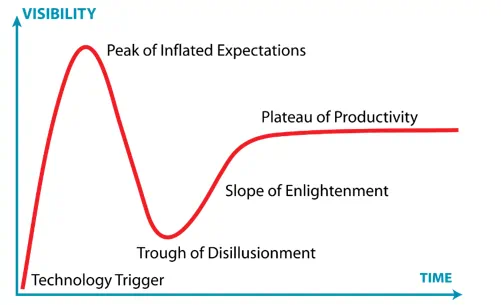Find out what several water technology thought leaders predict will be the biggest water technology trends 2020 and challenges in the water industry, including overcoming digital disillusionment, decentralised and innovative procurement.

A year for digital disillusionment?
Emma Weisbord, Digital Water Consultant, Royal HaskoningDHV
As the digital transformation of the water sector continues to increase in pace and scale, we predict 2020 will be the year of lessons learned and enlightenment. The last few years were marked by peaks of inflated expectations over several emerging technologies, notably blockchain and AI/ML, both enabled by the ability to outsource storage and computing to the cloud. While these technologies and others remain exciting tools to improve efficiency and reduce costs, the integration into business operations has been lacking.
Entering 2020, we can expect the water sector to move into a phase of disillusionment as some of these technologies fail to meet inflated expectations. The disillusionment phase is an important recalibration of our sector’s expectations over what and how new technologies can support business operations. However, we must remember that the slope of enlightenment is not far behind.
The key is to ensure that digital transformation is done with vision, purpose, and strategy. This brings us to the slope of enlightenment, which will be the key trend in 2020. The enlightenment trend of 2020 will be supported by change managers who will guide the water sector’s adoption and strategic integration of digital technologies.
Whereas the last few years highlighted technologists, we predict that 2020 will place a spotlight on the guides, those able to work between business and technology to seamlessly integrate the two.
This next year is when the rubber hits the road on large scale digital transformation. The water sector will need change agents to help establish vision, value, business imperatives, identify wins and friction points, and set out strategic roadmaps for water utilities.
The slope of enlightenment will continue to be lit by these guides, leading the water sector onto the plateau of productivity, where technologies are integrated to reduce business costs and increase efficiency, allowing us to achieve our goal of universal access to safe water and sanitation.


Innovative procurement for complex solutions
Tertius Rust, Head of Digital/Utilities, Jacobs
The industry has made enough progress in 2019 to enable the mass adoption of digital transformation projects in 2020 for small and big utilities. This is based on the following three trends in 2020:
Internet of Things (IoT) at Scale: Leading utilities will start transforming ambitious digital pilot projects into full scale deployment initiatives. Anglian Water Services and PUB Singapore have pushed for major Smart Metering projects. We are now witnessing first-hand the maturity of this IoT technology as the catalyst for major digital transformation and the foundation for more complex data benefit realisation initiatives. Water organisations will start to leverage this information in new ways to deliver operational efficiencies, communicate more effectively with their customers, provide behavioural insights to improve conservation and, also perform better on the new customer experience performance measurement set out by the UK Water Regulator Ofwat.
Partnerships Agreements: The utilities supply chain market will also transform from battle for use cases to signing more partnership agreements as leading solution providers scramble to identify synergies that best suit their offering and complement other more traditional offerings. As utilities become more comfortable with their digital abilities, they will start engaging with other service providers in their area to build stronger business cases to share digital infrastructure cost and optimise data benefit realisation across sectors. Jacobs has witnessed some of these benefits already through their partnership with South East Water UK, as the deployment of their smart networks trial incorporated a wide range of technology suppliers to provide a solution rather than a product. has been widely praised in 2019, I expect more companies to follow this collaborative approach in 2020.
Procurement Routes: As the innovation capacity of utilities suppliers to absorb digital transformation accelerates in 2020, it will be the procurement teams will need to find new and innovative ways to accommodate these new complex solutions. Particularly, with different stakeholders and wider, more complex outcomes, as social value and natural capital becomes increasingly prominent. I believe the more mature utilities will find collaborative procurement routes to bring a much wider supply chain into a common vision, accelerating the deployment of digital solutions as the risk and reward is shared in performance-based contracts.
In addition to this, the introduction of the ‘Bid Assessment Framework’ by Ofwat to allow third party competition into the area of Water Resources, Leakage Management and Demand Side Management, will make its entry into the market as this theoretical approach turns into practical implementation.

Addressing the wider water economy
Mark Kaney, Director of Asset Management, Black & Veatch Europe
Sustainable water use agenda will increasingly impact industry
Work looking at the wider water economy will continue and the focus on the water use of industries such as fashion, automotive (it takes about 39,000 gallons of water to produce the average vehicle) and farming will increase. Major companies are putting initiatives in place, but the issue will become more part of the water scarcity agenda.
Water scarcity estimates will deteriorate
Estimates for major cities likely to run out of water will shorten due to:
- Climate change: Less rainfall will impact some cities as their strategies for increased supply resilience is based around assumed rainfall patterns.
- Population movements: The trend of people moving into major conurbations will continue, placing strain on cities’ abilities to both meet demand and service its inhabitants without incurring major incidents and asset failures.
- Investment Strategies: Investment strategies continue to focus on the short term with long term investment confidence remaining low. This means some of the more necessary systemic changes in asset capabilities will not be driven through. Regions will continue to “kick the can down the road” in terms of dealing with ageing infrastructure and enhanced performance requirements competing against financial pressures of ROI and political will to keep bills low.
Technology adoption will continue to be slow
Water 4.0 is moving out of the hype and excitement period into the unsure and confused period! The solutions, products and services available are becoming more dispersed and varied in quality and capability. How these solutions can be linked to solving utilities’ immediate issues is proving hard. The issue of procurement challenge and risk has not gone away, and we will continue to work through these next year; so adoption will continue to be patchy and enterprise benefits to customers won’t materialise as hoped for 2020.

2020: Digital, decentralized and democratized
Will Sarni, CEO, Water Foundry
In the world of water, 2019 was an inflection point and in some respects a departure from the past. The digital transformation of the water sector took hold, centralized water systems continue to fail calling attention to the opportunities with decentralized systems and we moved closer to democratizing access to real time data, actionable information and alternative hydration.
Looking ahead to water technology trends 2020, I see three major trends.
Digital: Analog water solutions are well on their way to extinction as the digital transformation of the water sector accelerates. Digital water technologies continue to scale with public and private enterprises and the innovation pipeline for new digital technologies is thriving. Digital technologies and start-ups such as satellite data acquisition for real time water quality monitoring and flood prediction, AI applications for asset and resource management and real time water quality monitoring at the tap are scaling.
Decentralized: Centralized water systems are aging, underinvested and increasingly fail. Decentralized (and distributed) water systems are emerging as viable alternatives to capital intensive centralized water systems. These decentralized systems are more resilient to extreme weather events and provide more affordable alternatives to capital intensive centralized systems.
Democratized: The tragedy of lead contamination of drinking water in Flint, Michigan was not an isolated occurrence and served as a wake-up call that democratized access to real time data and actionable information is now essential. Imagine if the residents of Flint had affordable and reliable real time water quality data at their taps? Imagine if safe drinking water was available via small scale air moisture capture technologies?
Don’t view these as separate trends. For example, digital technologies are enabling the adoption of decentralized systems and democratized data and information and access to water. 2020 will be the year of digital water fuelling decentralized and democratized access to water.

What will 2020 hold for UV-C LED systems?
Oliver Lawal, Founder/CEO of AquiSense/IUVA Past-President
Aquatech 2019 saw more than a dozen examples of integration of UV-C Light Emitting Diodes (LEDs) into water treatment products. So what has changed and will this trend continue into 2020?
All new technologies have a combination of factors driving their commercial success; solve a real problem, available at an acceptable price/value ratio, fully reliable over the service life.
Solve a real problem
Ultraviolet water treatment has grown strongly over the past decades, however, mercury-vapor lamps have operational limitations (large footprint, start-up time, cycling restrictions, heat generation, replacement intervals, footprint, mercury content). UV-C LEDs provide an equal level of disinfection benefit, while overcoming the operational limitations. This results in the possibility to replace traditional UV technology with UV-C LED technology, though perhaps more importantly, to deploy new applications.
Price/value ratio
The first commercial UV-C LED product had a $12,000 build cost in 2012 for a disinfection flow rate of around 2 lpm. The same performance could be had for around $1,000 in 2015 and now in volume supply for less than $50. The core function has not changed but the value has increased dramatically as the manufacturing cost of UV-C LED devices has dropped. UV-C LED water treatment products have solidly moved from evaluation stage to mass production over the past year for the leading providers and this will accelerate over 2020.
Reliability
Mass production supply demands that manufacturers establish strong supply chains and product assembly processes. This is in evidence today with several suppliers showing generic third-party certifications like CE, UL, IEC and ISO. Perhaps more important are product specific certifications like NSF/ANSI, that provide high levels of industry confidence. NSF has made a huge contribution in 2019 by releasing an update to Standard 55. It has provided an alternate certification route for non-mercury-vapor lamps by not specifying 254nm as the only effective wavelength. This has established a more modern approach to target microorganism reduction level and low water quality modifier techniques.
Overall it seems clear that UV LED technology has a bright future in the disinfection market.

Reducing emissions across the water supply chain
Frederick Royan, Global VP Research in Sustainability & Circular Economy, Frost & Sullivan
Our top predictions for 2020 in the global water market include:
Climate Action – Net Zero Initiatives
Climate has become central to the global agenda with 60 countries committing to net zero targets for 2050. The UK Water Utility sector has committed to a target of net zero by 2030. Suppliers to other water segments such as industrial, commercial and retail too will get onboard in rolling out initiatives and services in reducing emissions both within their supply chains, operations and customers.
Sustainability Roadmap to 2030
The Sustainability Development Goals (SDGs) and related indicators have enabled water utilities, industries and the broader supply chain of the water industry in achieving some of the much needed efficiency improvements. 2020 is set to become a year of re-calibration to equip themselves with the necessary technology & services as we witness a crescendo of action aimed at realizing the vision of sustainability in the water sector.
IoT Sensors
IoT sensors are set to disrupt the broader water and wastewater treatment infrastructure segments. These sensors will be capable of directly communicating with smart phones or tablets whilst also providing a highly intuitive web interface and eliminating the need for terminal boxes.
Micro pollutants & PFAS control regulation:
Micro pollutants and PFAS has now emerged as an critical issue that requires regulatory attention, US EPA has launched a PFAS action plan to restrict the use of certain toxic PFAS components and also to develop standards for control & treatment. Significant investments are set to be made for treatment of micro-pollutants and PFAS particularly in North America and Europe – with Germany alone set to invest about €10 billion.
Service 4.0
Digital transformation in water utility and industrial water services is centred around the customer and we will see new initiatives and solutions in enhance customer service interaction and engagement to tap into the demand-side efficiency improvements.







